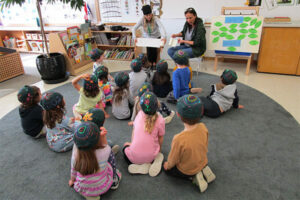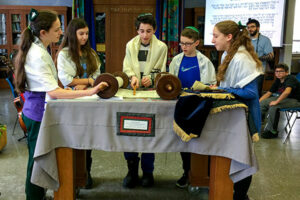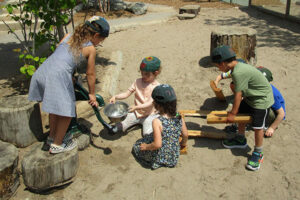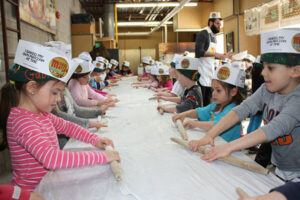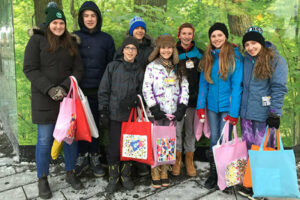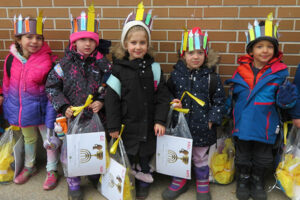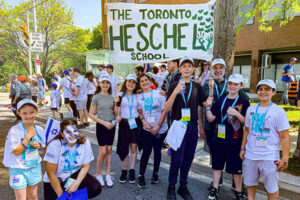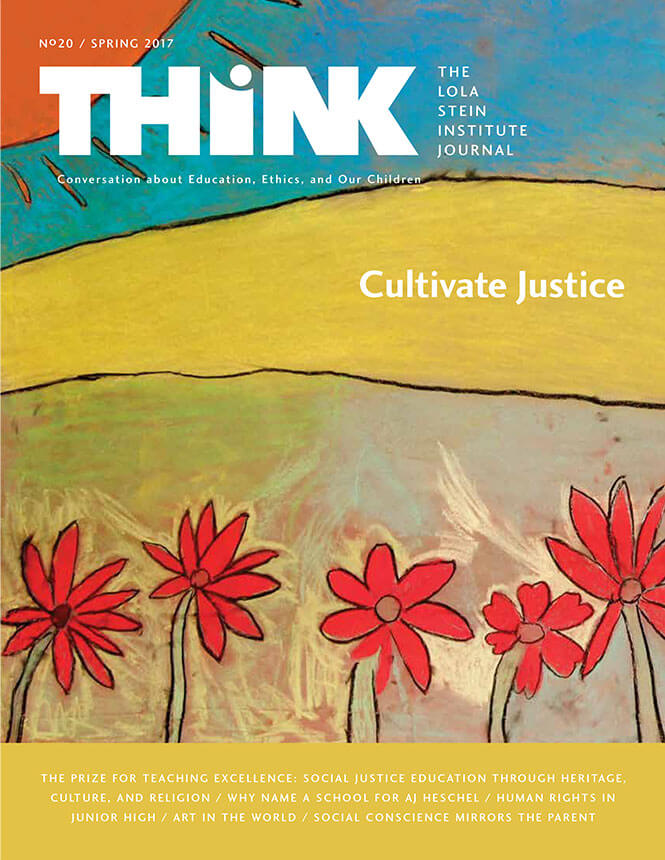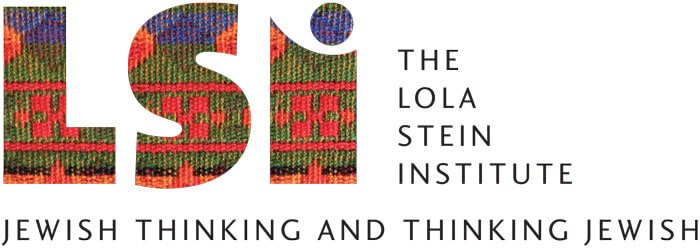- How We Teach

- First Column
- Second Column
- Third Column
- Case Studies

- First Column
- Second Column
- Culture & Community

- First Column
- Second Column
- News & Views

- Admissions

- First Column
- Second Column
- Support Us

- About

- First Column
- Second Column
- Parent Hub
- Attend an Open House
- Take a Tour
- Donate Now
- Calendar
- Blog
- 416-635-1876
- Search
Learning to Solve Real Problems at Ages 4 and 5
Consider this scenario: Noah and Rachel are playing side-by-side with blocks on the carpet of the Junior Kindergarten classroom. Accidentally, Noah knocks down Rachel’s structure and she starts to cry. In return, she hides the unused blocks so Noah can’t build anymore. What happens next is fascinating.
Noah tells Rachel that they need to go to the “conflict centre,” and the two walk to the corner of the room where they proceed to use a set of conflict resolution tools to end their squabble. The tools consist of cards depicting emotions that the children select to show how the clash has made them feel, as well as a board that offers various options to resolve their disagreement, such as to apologize, talk it out, or to simply breathe deeply and relax.
Noah explains to Rachel that he is upset because she is hiding the blocks, and she responds that she got angry when he ruined her creation. They each apologize and decided to share the blocks but sit farther from one another to avoid more collisions. Then they return to the carpet and resume their activity.
This glimpse into how four-year-old children resolve problematic social interactions is not an isolated occurrence in the JK classrooms at The Toronto Heschel School, nor is it something that happens spontaneously. It’s part of a highly intentional and detailed social and emotional learning curriculum for the Early Years; it also reflects the school’s overall approach to social justice education.
Last year THINK magazine launched a contest to discover and celebrate how teachers in other schools use their heritage, culture, or religion to inspire social justice values in their students. We were surprised not to receive any entries relating to students younger than Grades 7 or 8. I went into the Learning Centre to ask Heidi Friedman, Toronto Heschel’s Director of Early Years (JK-Grade 1), when and how social justice learning begins for young children at The Toronto Heschel School.
Simply put, she explained that the way in which young children relate to one another and to the adults in their early lives grounds how they embrace the pursuit of social justice later in life. First, her students are helped to develop a positive sense of self and an awareness of their personal feelings. Next, they focus on compassion and building good relationships with their peers. And finally, they shift this awareness outside the classroom to the rest of the school.
When I heard Heidi describe this approach, I understood how important it is for this social and emotional focus to be part of the conversation about social justice education; it is the cement for the building blocks for everything to come. Core behaviours and values that are important for sophisticated social justice projects in higher grades are seeded and nurtured very early in the children’s schooling.
Heidi described a few samples from the JK and SK programmes. In early autumn, the Junior Kindergarten children study the Torah’s description of the seven days of creation. They learn that on the second day, God separates light from darkness and gives each a name. The children apply this notion of distinctions to differentiating and identifying their feelings in different situations. They use emotion cards to name their feelings. Teachers maintain continual focus on each child’s progress, pointing out when each seems to be expressing various emotions.
Once the children can articulate their feelings, they consider what it means to act on them in a responsible way. In mid-winter, a new JK overarching theme is introduced: “When we know our feelings, we can act responsibly.” The theme works with the Jewish holiday of Purim that celebrates how a wise Mordechai and a courageous Esther saved the Persian Jewish community from the evil Haman who sought to destroy them. Reading Purim Megillah, the ancient text of the holiday, and using it as a springboard, the teachers reinvoke the autumn learning and the children now identify the feelings of the characters in the Purim story. They have been practicing all year!
They evaluate the actions of each Purim story character as a response to feelings, and they reflect on whether each was acting responsibly or not. For example, perhaps Vashti felt angry when King Achashverosh ordered her to come to his party, and perhaps this is why she did what she did. They discuss what she might have done and what might have happened next. The children draw up their own Megillah highlighting the Purim characters’ feelings and actions as the narrative evolves.
The integration of social and emotional learning with Jewish studies continues in Senior Kindergarten. An integrated SK theme for Chanukah —the holiday that celebrates the Jewish resistance to attempts by the Syrian-Greeks to end their practice of Judaism—is that “Jewish practices and learning give strength to our neshamah (our soul).” Teachers describe the neshamah as a flame that is fed the oxygen it needs through acts of kindness and mitzvot (the commandments). The children consider what was happening to the neshamah of the Jewish people during the Greek occupation of Judaea at the time of the Maccabees. Did oppression nurture or dampen the flames of their souls? They reflect on how and when their own neshamot expand or contract.
In SK, when a child is sick and misses school, the class takes the time to call him/her on the phone with wishes to “get well soon.” When the student returns to school, the teacher asks: “How did your neshamah feel when we called you?” Teachers ask their students how they might make a classmate’s “neshamah” feel better if he/she seems upset. Through ongoing one on one conversations, teachers discuss with each child what he/she might do to make a difference in how someone feels.
Talking to Heidi Friedman reminded me of the awe that I always feel for the mastery of teaching kindergarten. Her curriculum shows how social justice learning— in its purest Jewish sense— gets a solid start when it begins early and is rooted tenderly and simultaneously in social-emotional and Jewish foundations. Esther saved her world through mindfulness and courage. Judah Maccabee won his day by caring for the souls of his community. And classmates feel better when they know they are missed. So begins the social conscience of the responsible thinkers and young activists who are nurtured at Toronto Heschel.
Dvora Goodman , CoordinatorDvora Goodman is a Jewish educator with over twenty five years of experience in educational administration and Jewish experiential learning in various settings. She is the coordinator of The Lola Stein Institute. She is also an educational consultant to various Jewish educational organizations. Her current projects include UJA Federation of Greater Toronto where she has been coaching supplementary school leaders in the Greater Toronto area, and the iCenter for Israel Education where she has been helping Jewish camps and Jewish day schools infuse Israel into their settings.
PREVIOUS ARTICLE
Good Books by Gail BakerNEXT ARTICLE
Finding the Familiar in Grade 2Special Feature
Second PrizeTodd Clauer: Upper School Social Justice ProjectFirst PrizeErin Buchmann: Indigenous AwarenessA Report by Ruth BurnsteinThe Prize for Teaching Excellence 2016What Do We Have in Common?Finding the Familiar in Grade 2Our Sages Tell Us
A Mirror Reflection of UsThe Social Conscience of Our ChildrenColumns
An Interview with Dana EzerThe Jewish Foundations of a Junior High Human Rights CurriculumRecommendations for Children and the People Who Love ThemGood Books by Gail BakerPerspectives
 The Lola Stein Institute (LSI) is a centre of inventive educational thinking and addresses the challenge to re-frame schooling for the exigencies of our times.
The Lola Stein Institute (LSI) is a centre of inventive educational thinking and addresses the challenge to re-frame schooling for the exigencies of our times.

